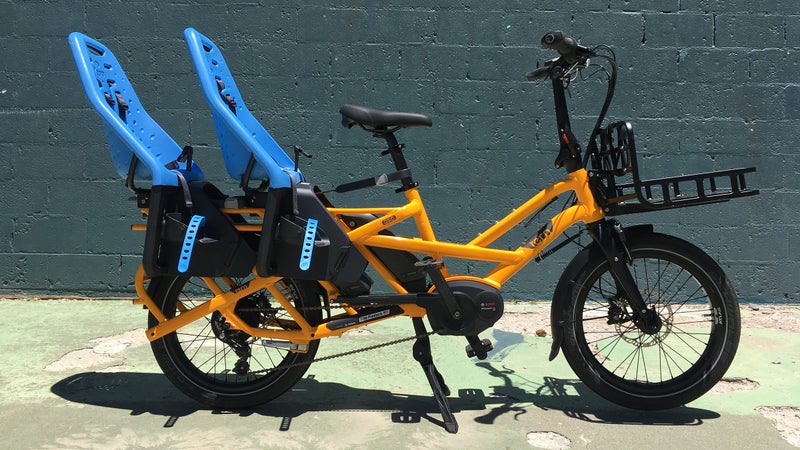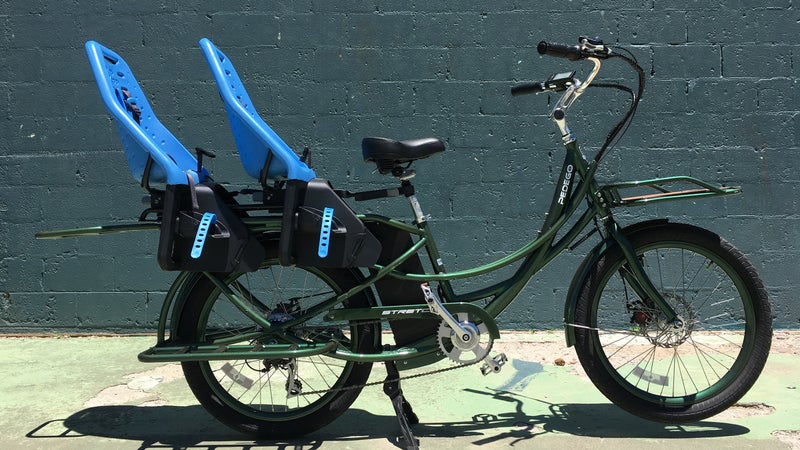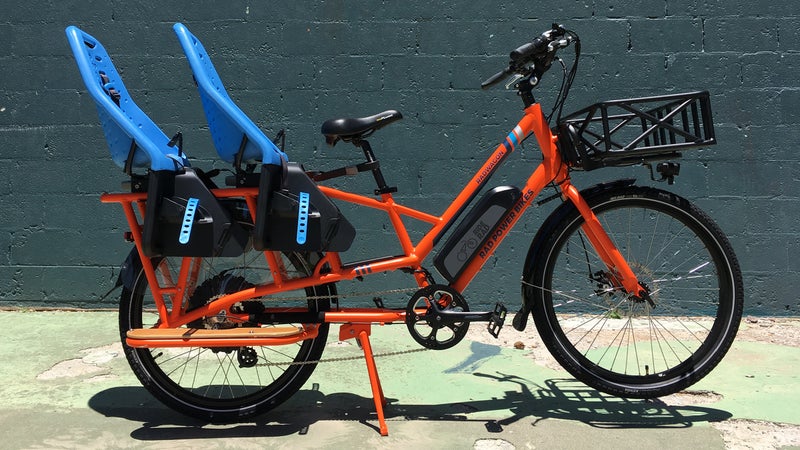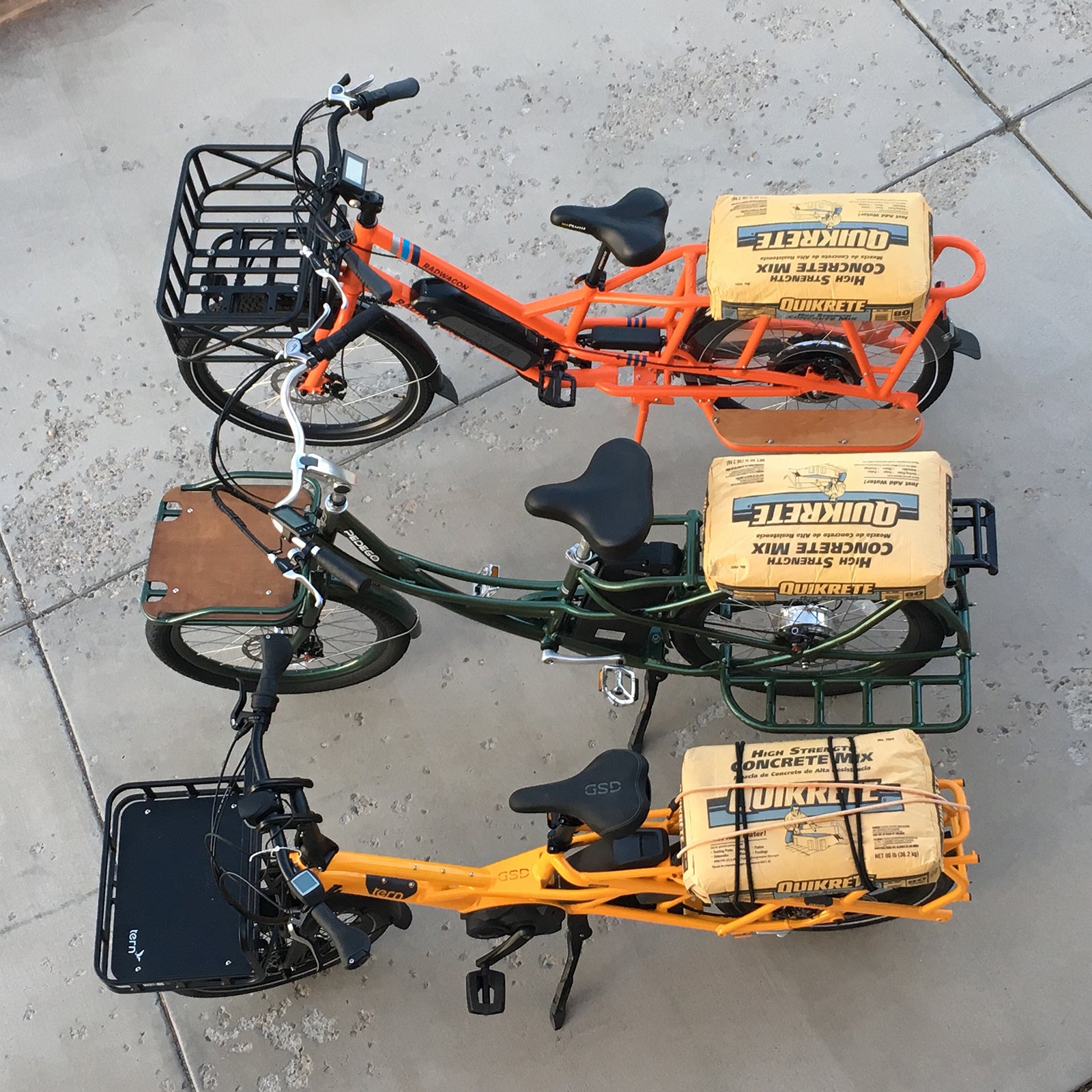In an effort to reduce my carbon footprint and make bike commuting a normal thing for my twin daughters (who aren’t old enough to ride their own bikes yet), I decided to get an electric cargo bike. If you’re rolling your eyes like my husband did when I said the word e-bike,��let me explain.
I live in Los Alamos,��New Mexico, elevation 7,500 feet. My commute to work is only three miles, but that three miles involves 250 feet of climbing and one day-care stop at the top of a very steep hill. I am a strong cyclist, but hauling 60 pounds’ worth of kids��up a 14 percent grade��in a trailer behind my commuter bike is too much—unless I want to pack a change of clothes and shower at work, which I don’t. I want to hop on a bike that can comfortably carry my lunch, a few personal items, and my kids’ school stuff; drop off the kids without breaking a sweat; cruise into work; and park ten feet from my building. An e-bike allows me to do that.
As I began researching, I quickly realized that e-cargo bikes range from kind of expensive to very expensive. I didn’t really want to spend a lot of money, but I also didn’t want to end up with a bike that was unreliable on steep hills or felt unsafe in any way, especially with my kids on board.
I ended up testing three e-cargo bikes at different price points: the ($5,800 for the dual-battery option), the ($4,300), and the ($1,500). These bikes met my main criterion: they can carry two child seats. (Side note: the $250 price tag on these seats is worth every penny; they are safe, comfortable, and super easy to get on and off a bike. Plus��they accommodate kids up to 50 pounds, so you should get years of good use out of them.)
The Test
For a month, my husband and I rode these bikes to work and around town. Sometimes we used them to carry��the kids and��sometimes groceries, gym clothes, or library books. Once I tried to carry my 50-pound dog, but he wasn’t a fan (I’ll keep trying). I also loaded up each bike with an 80-pound bag of concrete mix and rode the same four-mile loop. (My twins weigh in at 25 pounds apiece, and I wanted to see how these bikes would handle more weight.)

Pedal Assist
The RadWagon and the Stretch each have a five-level pedal-assist system that you operate with your left hand��and a gear shift and throttle that you operate with your right hand. Pedal assist only works when—surprise!—you’re pedaling. For the RadWagon, level one provides a gentle boost, whereas��level five is much more aggressive, giving you a full 750 watts of power. Your speed and the amount of assist will depend on a variety of factors, such as how much you’re pedaling and if you’re going up- or downhill.��
The pedal-assist system on the Stretch provides whatever power is necessary to maintain a certain speed—kind of like cruise control. So pedal-assist level five, for example, will kick you up to 20 miles per hour��on flat terrain. You’ll go slower��if you’re going uphill.��
The throttle on both the RadWagon and the Stretch propels the bike forward without pedaling. I found that, for these two bikes, a twist of the throttle is helpful to accelerate from a complete stop.��
The Tern GSD S00 also has a pedal-assist system that you operate with your left hand, but it has four levels of assist: eco (which matches 50 percent of your power output), tour (120 percent assist), sport (190 percent), and turbo (300 percent). Instead of a traditional indexed gear shifter on the right side, the bike has a twist-grip shifter that’s connected to an infinitely variable gear-range rear hub. Just twist the shifter down to get more resistance on the pedals��or up to make pedaling easier.��The bike’s 20-inch wheels accelerate more easily than the 24-inch wheels on the Stretch or the 26-inch wheels on the RadWagon, and the motor’s sensors (more on that below) help out, too, so I didn’t miss the bike’s lack of a throttle when accelerating from stop signs and lights.
For all three bikes, per federal regulations, the pedal assist (as well as the throttle for the RadWagon and the Stretch) shuts off once the bike hits 20 mph, but you can go faster using your own power or gravity.
Battery
Battery life depends on a variety of factors, including your level of pedal assist, your weight, your cargo, and any��hills or��headwinds you might encounter. RadPower��advertises 45 miles per charge (and five hours to recharge the battery), Pedego advertises 50 miles (and three hours to recharge the battery), and Tern advertises 124 miles between its two batteries (and more than five hours to recharge). Because of my short commute, this was not a significant factor for me. But I did have a friend borrow the RadWagon for her 20-mile, round-trip commute, and she got there and back—and up some crazy hills—just fine, although the bike definitely needed to be charged afterward.
Motor and Ride Feel
The Stretch’s 500-watt geared motor is the loudest of the three and sometimes takes a few seconds to engage (and it’s amazing how hard normal pedaling can feel during those few seconds). But once it kicks on, you can quickly reach 20 mph and be on your way. The RadWagon’s 750-watt Shengyi direct-drive hub motor is really quiet and engages immediately for a smooth ride, but it doesn’t punch up hills quite as well as the Stretch does.��
The GSD S00 uses a Bosch Performance Line CX 250-watt motor that relies on��torque, cadence, and speed sensors to measure your pedaling and blend in a proportional level of assist. This motor is like the little engine that could; though it’s less powerful than the other two, it’s��smooth, steady, and reliable.
Style and Fit
The Taiwanese GSD S00, with its smaller wheels, folding handlebars for ease of storage, and occasional mechanical noises, is like a robot on wheels. The Stretch, hailing from Orange County, California,��is a classic cruiser with swooping geometry and a plush memory-foam seat. And the Seattle-made RadWagon, even at a whopping 79 inches long, has more of a standard city-bike look and feel.��

Weight and Cargo
Each of these bikes weighs about 75 pounds. When you add attachments (front racks, child seats, panniers, etc.), plus whatever you’re going to be hauling around, odds are good that the loaded bike weighs more than you do. You have to use some serious muscle to get the kickstands up and even walk the bikes. Also keep in mind that fully loaded bikes are typically back heavy, which makes them even more unwieldy to walk beside and ride.
The GSD S00 has 20-inch wheels and sits much lower to the ground than the RadWagon��or Stretch. This lower center of gravity makes it feel more stable with a heavy load in the back. When the RadWagon��and Stretch were loaded up, they (the RadWagon in particular) tended to wobble at very low speeds, which is terrifying at first, but once I mastered using the throttle to accelerate from a stop, getting going was much smoother.
The total payload capacity—rider plus cargo—for these bikes is 440 pounds for the GSD S00, 400 pounds for the Stretch, and 350 pounds for the RadWagon.��
Hauling two kids on the back of a bike means that you can’t also have panniers back there, which means��your cargo space is limited to a front rack. Of these three bikes, the Stretch is the only one that comes with a front rack (using a bungee cord, I attached��a milk crate to the rack—which is actually more like a shelf—to accommodate more stuff). The GSD S00 and the RadWagon also have strong, shelflike front racks, but they’ll cost you an extra $69 or $120, respectively.
When you are sans kids and want to haul stuff in back, note that the frames of the built-in back racks on these bikes are thicker than the racks you might buy off the shelf and attach to a standard bike. Not all bungees and panniers will work. To play it safe, purchase accessories directly from the bike company.��
On the RadWagon, I used RadPower’s ��(a $79 add-on), with a waterproof ($59), and easily could carry everything I needed for commuting, even during New Mexico’s summer monsoon season.
Hills
I live in a very hilly town, and each of these bikes made conquering the ascents considerably easier. The��Stretch was the fastest on the hills. With 80 pounds of concrete mix on the back, I put it in pedal-assist five and a low gear and cruised up a steep, 10 percent grade at nine��mph with no problem. The GSD S00 was just as reliable but a bit slower at the highest level of assist and��the same level of effort. On the RadWagon, however, I found that��even in pedal-assist five��and a low gear, my quads were burning a bit more than on��the other bikes and I went��the slowest (about seven mph).��

Kickstand
I loved the RadWagon’s metal, double-leg kickstand: it’s super easy to get up and down, even with two kids on the bike. The GSD S00 and the Stretch actually have the same terrible kickstand as one another. Each time I used it, I thought I might break a toe—and it didn’t get better the more I used it. In fact, I found this kickstand so difficult to use that I often chose to ride the RadWagon simply so I wouldn’t have to battle the others’ stubborn kickstand.��
The GSD S00 and the RadWagon have built-in handles under their seats to help lift the bike to release the kickstand, which is very��helpful when you’re��trying to lift something that weighs nearly as much as you do.
Design Details
I found each bike to be thoughtfully designed. For example, they all come with disc brakes, fenders, and integrated front and rear lights. Here are a few more things I loved about��each:
- GSD S00: The back rack doubles as a stand if you want to store the bike vertically, and the handlebars fold��down if you want to fit the bike in a small space, such as a car or an elevator. An integrated lock on the front wheel means you’ll always have a way to keep the bike secure.
- RadWagon: The brake lights, regenerative braking (engaging the brake levers helps recharge the battery), puncture-resistant tires, attractive wood paneling (on the rear rack and foot rests), and USB port for charging electronics, are all great features. Plus, you don’t have to move your left hand to use the pedal-assist system, and the screen sits right in the middle of the handlebars, making��it easy to glance down and��check your speed and distance.
- Stretch: The seat folds forward, so��you can lift the battery out and take it with you to charge. The bike itself has beautiful wood paneling,��easily adjustable handlebars (with leather grips) to accommodate riders of different sizes,��and��side and back racks that can be moved around to accommodate different sizes and shapes of cargo. It also has a��USB port.
The Verdict
At the end of the day, unsurprisingly, the priciest ride—the Tern GSD S00—was the best all-around bike I tested (although, because of its tiny wheels and folding handlebars, I thought of it not as a bike but rather as an electric commuting vehicle). It was the most stable bike to ride fully loaded, even uphill (though it definitely struggled with hills more than the less expensive Stretch), and with the twist shifter, I could seamlessly dial in the right amount of resistance without a jerky ride. And��should I ever need to cover some serious distance, the dual batteries would have me covered.
However, for $4,300 less, the��RadWagon��will still get you from A to B, though it’s the most work to ride uphill��and you sacrifice battery life. The RadWagon is also less stable when fully loaded (the front end feels more wobbly than the GSD S00), but you’ll learn to handle it better with every ride—it just takes practice. Keep in mind, however, that because RadPower sells bikes directly to consumers��(one way it��keeps prices down), you’ll either have to assemble it yourself or take it to your local bike shop.��
The Stretch provides a happy medium—though $4,300 is still an��investment. If speed and performance on hills are��most important to you, this is your bike. If you love the classic beach-cruiser look and feel, this is your bike. I’d just recommend that you replace the kickstand, and to help with that (and anything else), Pedego has more than 125 dealerships located around the country.


